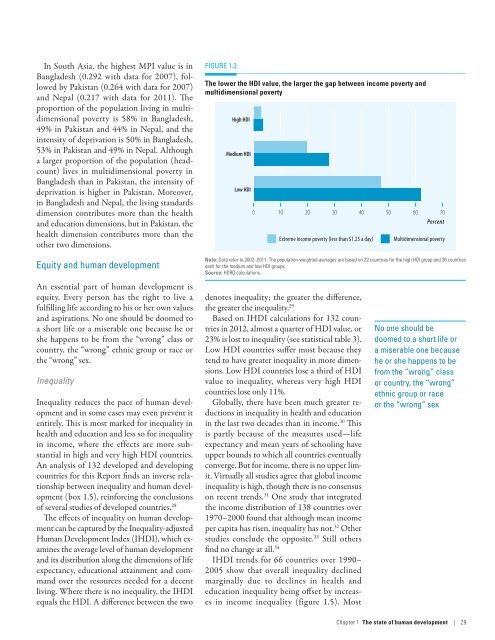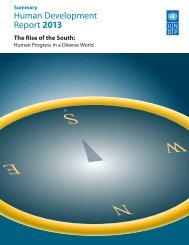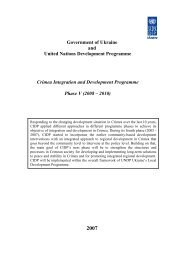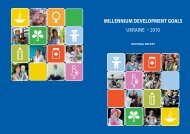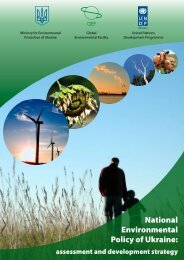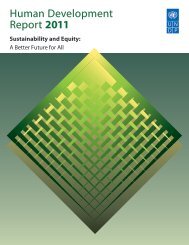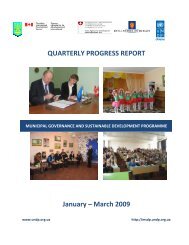E N S W - United Nations Development Programme
E N S W - United Nations Development Programme
E N S W - United Nations Development Programme
You also want an ePaper? Increase the reach of your titles
YUMPU automatically turns print PDFs into web optimized ePapers that Google loves.
In South Asia, the highest MPI value is in<br />
Bangladesh (0.292 with data for 2007), followed<br />
by Pakistan (0.264 with data for 2007)<br />
and Nepal (0.217 with data for 2011). The<br />
proportion of the population living in multidimensional<br />
poverty is 58% in Bangladesh,<br />
49% in Pakistan and 44% in Nepal, and the<br />
intensity of deprivation is 50% in Bangladesh,<br />
53% in Pakistan and 49% in Nepal. Although<br />
a larger proportion of the population (headcount)<br />
lives in multidimensional poverty in<br />
Bangladesh than in Pakistan, the intensity of<br />
deprivation is higher in Pakistan. Moreover,<br />
in Bangladesh and Nepal, the living standards<br />
dimension contributes more than the health<br />
and education dimensions, but in Pakistan, the<br />
health dimension contributes more than the<br />
other two dimensions.<br />
Equity and human development<br />
Figure 1.3<br />
The lower the HDI value, the larger the gap between income poverty and<br />
multidimensional poverty<br />
High HDI<br />
Medium HDI<br />
Low HDI<br />
0 10 20 30 40 50 60 70<br />
Percent<br />
Extreme income poverty (less than $1.25 a day)<br />
Multidimensional poverty<br />
Note: Data refer to 2002–2011. The population-weighted averages are based on 22 countries for the high HDI group and 36 countries<br />
each for the medium and low HDI groups.<br />
Source: HDRO calculations.<br />
An essential part of human development is<br />
equity. Every person has the right to live a<br />
fulfilling life according to his or her own values<br />
and aspirations. No one should be doomed to<br />
a short life or a miserable one because he or<br />
she happens to be from the “wrong” class or<br />
country, the “wrong” ethnic group or race or<br />
the “wrong” sex.<br />
Inequality<br />
Inequality reduces the pace of human development<br />
and in some cases may even prevent it<br />
entirely. This is most marked for inequality in<br />
health and education and less so for inequality<br />
in income, where the effects are more substantial<br />
in high and very high HDI countries.<br />
An analysis of 132 developed and developing<br />
countries for this Report finds an inverse relationship<br />
between inequality and human development<br />
(box 1.5), reinforcing the conclusions<br />
of several studies of developed countries. 28<br />
The effects of inequality on human development<br />
can be captured by the Inequality-adjusted<br />
Human <strong>Development</strong> Index (IHDI), which examines<br />
the average level of human development<br />
and its distribution along the dimensions of life<br />
expectancy, educational attainment and command<br />
over the resources needed for a decent<br />
living. Where there is no inequality, the IHDI<br />
equals the HDI. A difference between the two<br />
denotes inequality; the greater the difference,<br />
the greater the inequality. 29<br />
Based on IHDI calculations for 132 countries<br />
in 2012, almost a quarter of HDI value, or<br />
23% is lost to inequality (see statistical table 3).<br />
Low HDI countries suffer most because they<br />
tend to have greater inequality in more dimensions.<br />
Low HDI countries lose a third of HDI<br />
value to inequality, whereas very high HDI<br />
countries lose only 11%.<br />
Globally, there have been much greater reductions<br />
in inequality in health and education<br />
in the last two decades than in income. 30 This<br />
is partly because of the measures used—life<br />
expectancy and mean years of schooling have<br />
upper bounds to which all countries eventually<br />
converge. But for income, there is no upper limit.<br />
Virtually all studies agree that global income<br />
inequality is high, though there is no consensus<br />
on recent trends. 31 One study that integrated<br />
the income distribution of 138 countries over<br />
1970–2000 found that although mean income<br />
per capita has risen, inequality has not. 32 Other<br />
studies conclude the opposite. 33 Still others<br />
find no change at all. 34<br />
IHDI trends for 66 countries over 1990–<br />
2005 show that overall inequality declined<br />
marginally due to declines in health and<br />
education inequality being offset by increases<br />
in income inequality (figure 1.5). Most<br />
No one should be<br />
doomed to a short life or<br />
a miserable one because<br />
he or she happens to be<br />
from the “wrong” class<br />
or country, the “wrong”<br />
ethnic group or race<br />
or the “wrong” sex<br />
Chapter 1 The state of human development | 29


